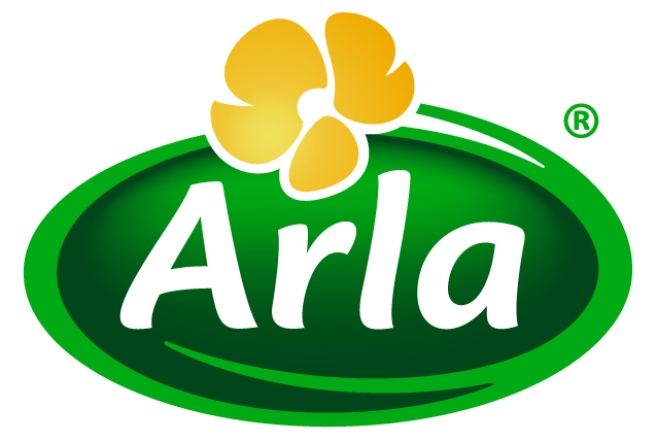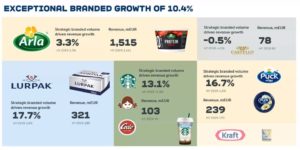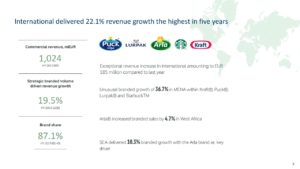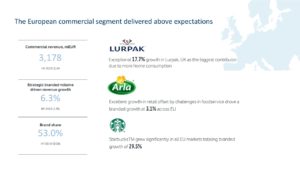The Covid-19 pandemic defined the first half of 2020 and it showed the need for reliable food systems as countries had to shut down. Arla moved quickly to safeguard its people, operations and finances around the world and being well positioned both geographically and across categories, Arla utilized the company’s agility to successfully keep the business running despite global logistics and supply chain challenges. In the first half year Arla’s global branded sales volumes grew an unprecedented 10.4 per cent and the cooperative delivered a strong and competitive performance price.
Click to enlarge
Total Arla Group revenue grew 2.8 per cent to EUR 5.4 billion compared to EUR 5.2 billion in first half of 2019, driven mainly by higher branded sales volumes in retail across markets. Arla grew profitability and achieved a net profit share of 3 per cent of revenue up from 2.3 per cent in the first half of 2019.
Despite the challenging global market circumstances, throughout the first half of 2020 the milk price to farmer owners remained stable at a competitive level. The cooperative’s performance price – which measures the value Arla creates per kilogram of owner milk – was at 37.0 EUR-cent compared to 36.1 EUR-cent first half year of 2019.
Arla’s transformation and efficiencies programme Calcium delivered savings above expectations at EUR 69 million despite the pandemic. Cost savings were mainly from efficiencies in indirect spends and optimization of supply chain operations.
Click to enlarge
Consumers
Consumers turned to trusted brands during pandemic As restaurants, coffee shops and canteens had to close due to the pandemic, Arla’s food service business declined rapidly. Consumers instead turned to trusted household dairy products as in-home cooking and consumption increased and this more than offset lost foodservice sales and lower commodity prices. Overall strategic branded sales volume increased an unprecedented 10.4 per cent. Global brands Lurpak® and Puck® grew impressive 17.7 per cent and 16.7 per cent respectively. Arla® was affected be the decline in Foodservice, but still delivered 3.3 per cent volume growth. Arla’s Milk Based Beverages (MBB) delivered 13.1 per cent volume growth, mainly driven by Starbucks®.
Commercial zones
Commercial zones perform above expectations Arla divides its business into two commercial zones, Europe and International. Although both zones were highly affected by the pandemic as first China and then most of Europe and the US restricted movement and travel creating logistics and supply chain challenges, both delivered strong financial results and branded volume growth.
Arla’s European foodservice business saw a steep reduction, but this was more than compensated by the strong performance of retail and a significant increase in e-commerce. The Europe zone delivered an exceptional branded sales volume growth reaching 6.3 per cent driven mostly by Lurpak®, Arla® and Starbucks®. Arla’s Europe zone grew revenue 0.9 per cent to EUR 3,178 million compared to EUR 3,149 million in the same period last year.
Click to enlarge
Arla’s International zone delivered the highest revenue growth in the past five years of 22.1 per cent seeing an increase to EUR 1,024 million compared to EUR 839 million in first half of 2019. Middle East and North Africa (MENA) was the main driver for the significant growth as home cooking and overall dairy consumption rose steeply due to lockdowns and curfews. All other international markets also contributed positively to the revenue growth. Overall branded sales volume growth reached 19.5 per cent.
In the first half of 2020 Arla Foods Ingredients (AFI) delivered a strong performance supported by stable operations and increased demand for AFI’s value-added products within pediatric, health & performance and food segments. AFI grew revenue 2.4 per cent to EUR 360 million, up from EUR 352 million in the same period last year.
Trading, which is business to business commodity sales, continued its strong position from 2019, but as Covid-19 impacted the global market commodity prices fell significantly and volumes were reduced as they were channeled into retail. Trading revenue decreased by 8.3 per cent in the first half of 2020, from EUR 861 million to EUR 790 million.
Financial expectations for full year 2020
The uncertainty around the duration and intensity of the economic and market impacts caused by the Covid-19 pandemic is expected to continue throughout the second half of 2020. Arla will focus on continuing to steer successfully through the coming deadline for Brexit negotiations and the looming global recession.
“On the short term, we are looking at two very severe and unpredictable risks for the second half of 2020. One being the covid-19 pandemic that continues to require us to be in crisis mode along with the potential adverse consequences surrounding Brexit negotiations. On the longer term we need the business to be ready to navigate successfully through the expected global recession. So, we must continue to be resilient and agile to ensure that Arla continues to be as robust and competitive as it is today,” says CEO Peder Tuborgh.
Despite the very uncertain external factors in mind, Arla still expects to meet its expectations for full year with revenue outlook 2020 at EUR 10.4 billion – EUR 10.8 billion, a net profit of 2.8 to 3.2 per cent of revenue and a year-end leverage at the bottom or below target range of 2.8 – 3.4.






